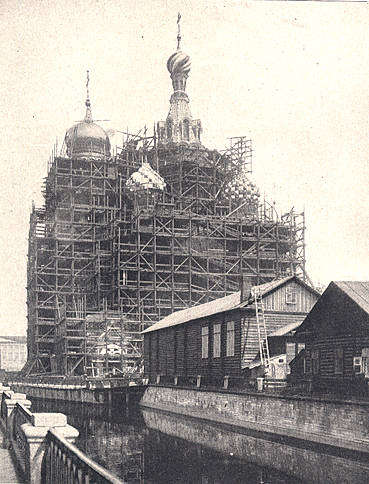   

In 1881 Tsar Alexander II, known as the Great Liberator for his emancipation of the serfs, was driving in his carriage along one of Petersburg's canals when he was blown up by terrorists who had been mascarading as cheese merchants. St. Petersburg society was shocked to learn that the assassins were children of the aristocracy who had been planning the murder for some time. Terrorists had been after Alexander II for years. They had pronounced a 'death sentence' against him. Once they had managed to blow up a couple of rooms in the Winter Palace where the Tsar was supposed to have dinner; fortunately for him, he was late. Unfortunately, many innocent people died.  Above: The bombing of Alexander II.
The terrorists chased Alexander II relentlessly - following his every movement trying to find a hole in the security around him. When Alexander travelled by carriage around the city he usually followed different routes - often changing them at the last minute to throw his pursuers off the track. This time he failed. One of the assassins managed to lob a bomb at his carriage which immediately killed several men in the Tsar's entourage. As Alexander came out of his carriage to help the wounded, his killer tossed a second grenade which blew off the Tsar's legs. He was carried back to the Winter Palace, bleeding profusely along the way, drops of blood marking the path he was carried up the marble stairs of the palace. In his room, he was laid upon a bed, his wife threw herself upon his bloody and mangled body - he was still alive - sobbing and crying hysterically. Other members of the Romanov family arrived, including Alexander's young grandson, Nicholas, who would himself be killed, along with his wife and children, by the next generation of revolutionaries. They watched the Tsar, brother, husband, father and grandfather, as well as Emperor, die; the first Romanov victim of the revolutionary movement.
Alexander was laid to rest under a huge cenotaph made of grey Siberian Jasper in the grave-church of his ancestors in Peter and Paul Fortress.
The murder of Alexander II shocked Russia. Out of a sense of national guilt it was decided to build a new cathedral to enshrine the pavement where Alexander had fallen. It was decided to use the old Russian style of architecture for the building, even though it was out of the classical character of the city. This photograph from 1900 shows the church almost completed. Although it looks like a 16th century Muscovite church there are many things about it which betray its' 19th century origin. The design of the church is much more orderly and symmetrical than a real 16th century brick church would have been and many of the elements are out of scale. The best artists of the day - including Vasnetsov - participated in its' decoration and the interior was encrusted in semi-precious stones from all over the Russian Empire. Golden mosaics lined the vaults and were even lavishly applied to the exterior of the church. Within the cathedral, a canopy made of jasper, with a multitude of hanging silver lamps was placed directly over the section of pavement where the murder had taken place. It was said the Tsar's blood stains were still there in 1900. A fantastic bronze fence was forged with flamboyant old-Russian motifs and placed within brick posts, encircling part of the exterior of the church. Positive reaction to the gaudy magnificence of the interior was overwhelmed by adverse comments on the exterior, which was modelled on St. Basil's Cathedral in Moscow and out-of-place in it's setting.
Next photograph: A St. Petersburg Cab Driver
For a small map of the St. Petersburg area click here.
To see a large map of the center
of St. Petersburg go here.
Comments on the website should be sent to Bob
Atchison. |
 |
|

